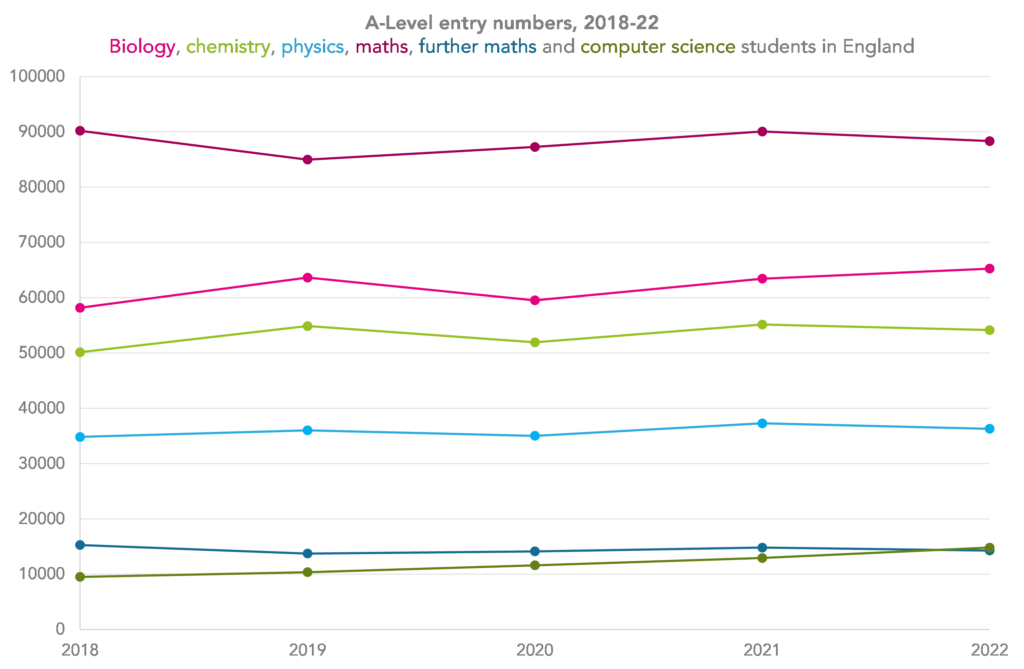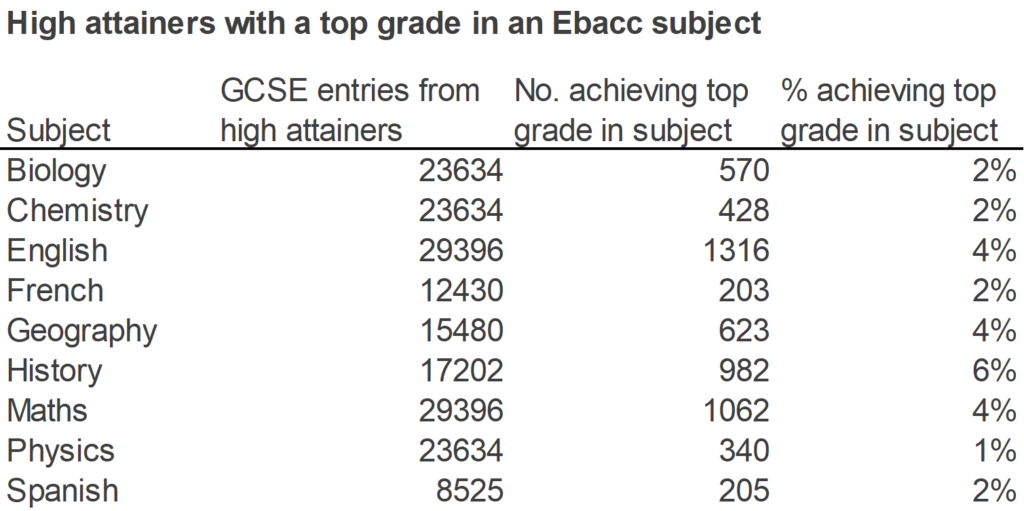A few weeks ago, I wrote a piece about the relationship between attainment at GCSE and KS5 subject choice.
As you’d expect, I found that pupils who did well in GCSE maths were more likely to go on to study maths at A-Level. And the same was true – to a lesser extent – for GCSE English and A-Levels in English literature or English language.
But (channelling Carrie Bradshaw) I couldn’t help but wonder – what about pupils who get strong grades across the board?
All-rounders
I’ll be using data from the Key Stage 4 and 5 exam tables in the National Pupil Database to identify high attaining ‘all-rounders’ at GCSE and the subject choices they went on to make. I’ll focus on pupils who took GCSEs in 2019 – the last year before the pandemic.
I’m defining these high attainers as pupils who achieved a grade 7 or above in all of the EBacc subject areas in which they took a GCSE.[1] That is, in English, maths, science, languages and humanities.[2] Around 5% of the pupils who took GCSEs in a state-funded school in England fell into this group.
Of course, some might argue that success in all of the EBacc subject areas doesn’t necessarily make a pupil an ‘all-rounder’. The EBacc subject areas do not include the arts, for example. But the government, for one, believes that the EBacc constitutes a broad curriculum.
So – do pupils who do well across the EBacc subject areas go on to study a broad range of subjects post-16? Their subject choices do look quite different to those of Key Stage 4 pupils overall.[3]
The charts below show the ten most popular KS5 subject choices for both groups. We’ll refer to those pupils who did well across all EBacc subject areas as ‘EBacc high attainers’ from now on rather than all-rounders.


The vast majority of EBacc high attainers (97%) entered a Level 3 qualification in 2021, two years after completing KS4, compared to 54% of all pupils. Among those who did go on to complete a Level 3 qualification, the choices of Key Stage 4 pupils overall were more evenly spread between subjects than those of the high attainers. High attainers were far more likely than their peers to pursue STEM subjects at A-Level, with maths, chemistry, biology and physics the most popular choices. More than half (58%) went on to study maths, compared to 13% of all Key Stage 4 pupils.
But the differences between EBacc high attainers and their peers were less marked in subjects such as English literature, psychology and geography.
So why is STEM so much more popular among high attainers? The popularity of biology and chemistry with high-achieving students may well be linked to the entry requirements for medical degrees – which usually include A-Levels in both subjects.
But it may also be the case that some schools and colleges require students to have a grade 7 or above in the relevant subject at GCSE in order to enter an A-Level. This may be more common for STEM subjects than for others, and may mean that lower-attaining students who would be interested in pursuing STEM subjects at A-Level are unable to do so.
2022 vs 2021
The pandemic years – which don’t have much else to recommend them – do give us an opportunity to explore how far A-Level entry requirements usually affect subject choice.
Pupils who took GCSEs in 2020 and 2021 were awarded grades via CAGs and TAGs respectively. And the proportion of GCSEs graded 7 or above, which stood at 22% in 2019, increased to 28% in 2020 and 30% in 2021.
Since a higher proportion of pupils would have had the grades often required to go on to study STEM subjects at A-Level, we might expect a boost to the numbers taking those subjects – if entry requirements are usually a barrier.
And, as we can see below, this isn’t what happened.[4]

Entries in chemistry, maths, further maths and physics were all lower in 2022 than in 2021. So it would appear that the difference in grading didn’t boost STEM entry numbers.
But on the other hand, given the last minute (and beyond) changes of policy around grading in 2020, pupils would have made their choices before plans were finalised. They may not have felt confident that they would achieve the necessary grades to pursue a STEM A-Level when making their choices, and might not have had the option to update their choices once they had received their GCSE grades.
The choices made by pupils who received TAGs in 2021 might be more telling. Of course, these pupils won’t have completed KS5 yet. We’ll be watching with interest when next year’s exam results are published.
Top grades
Returning from that tangent, let’s take a closer look at our group of EBacc high attainers.
I defined EBacc high attainers as pupils who achieved a grade 7 or above in all of the EBacc areas in which they took a GCSE. But some of those pupils may have achieved particularly high grades in just one of the EBacc areas – say, a grade 9 in maths, and grade 7s in the other areas. While those pupils might have had the grades to pursue any of the EBacc subjects at A-Level, wouldn’t they be more likely to pursue the one in which they achieved their top GCSE grade?
The table below shows the number of high attainers with a top grade in one of the EBacc subjects. These pupils achieved at least a grade seven in all of the EBacc subject areas they entered, and achieved at least one grade higher in their top subject than in any other EBacc subject.[5]

Most EBacc high attainers did not have a top subject in which they achieved a higher grade. Of those who did, most achieved their highest grade in English or maths, partly because these subjects were taken by every pupil in our group of high attainers by definition.
The chart below shows the top ten Key Stage 5 subject choices for high attainers with a top grade in one of the EBacc subjects. [6]
In most cases, these pupils were more likely to go on to study an A-Level in the subject in which they received their top grade. This is particularly noticeable for those with a top grade in maths – more than three-quarters (77%) went on to study A-Level maths, while just 26% went on to study the next most popular choice, chemistry.
But in one subject – physics – even those with a top grade in the subject were more likely to choose another option at KS5. Maths was the most popular option for these students, although physics itself was next on the list.
This may be because A-Level maths is an entry requirement for A-Level physics in some schools and colleges. We know that the vast majority of those who choose physics A-Level also take maths, and of course plenty of students take maths without physics.
Summing up
Pupils who achieve strong grades across all of the EBacc subjects are more likely to go on to pursue STEM subjects at A-Level than their peers.
But they’re particularly likely to go on to study the subject in which they achieved their highest grade. Although physicists might want to think about why their subject is the exception.
[1]: Where pupils took more than one GCSE in a subject, for example English literature and English language, we selected the highest grade. Pupils who did not take any GCSEs in one of the five subject areas were counted as high attainers if they achieved a grade 7 or above in all of the other five areas.
[2]: Pupils who achieved either 77 or above in combined science or a 7 or above in biology, chemistry and physics are included. The humanities are defined here as history or geography
[3]: We have included all pupils who completed KS4 in a state-funded school in England.
[4]: The 2022 NPD exam tables are not yet available for research, so this table is based on data from JCQ.
[5]: We have excluded languages with lower GCSE entry numbers – the languages included are French and Spanish.
[6]: ‘English’ A-Level includes all entries to either English literature, English language or English literature and language.

Want to stay up-to-date with the latest research from FFT Education Datalab? Sign up to Datalab’s mailing list to get notifications about new blogposts, or to receive the team’s half-termly newsletter.






Fascinating and really helpful! Perhaps A level/specialist subject teachers supply in STEM is a rate-limiting step here (that is, there ain’t that many, so expanding post-16 class sizes is a tough call) or whether the specialist subject teachers raised the bar for entry, and just like that (Bradshaw (1998) and ad nauseam) everything had to pretty much (re. entries) stay the same. Looking forward to seeing what comes of the 2021 TAG grades.
Hi Simon, thanks for the comment and SATC reference! You may be right about the number of specialist teachers curbing any increase in numbers. I will also be watching with interest to see what happens to entry numbers in the next few years…
Dear Natasha,
Thank you for this, very interesting. I believe we are still waiting for the 2022 Subject Progression from GCSE to A level from Ofqual or maybe it is just that I cannot find it on the internet.
2017: https://assets.publishing.service.gov.uk/government/uploads/system/uploads/attachment_data/file/610077/Progression_from_GCSE_to_A_level_-_Comparative_Progression_Analysis_as_a_new_approach_to_investigating_inter-subject_comparability.pdf
2012: https://assets.publishing.service.gov.uk/government/uploads/system/uploads/attachment_data/file/183942/DFE-RR195.pdf